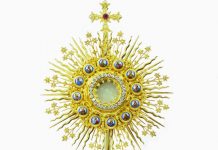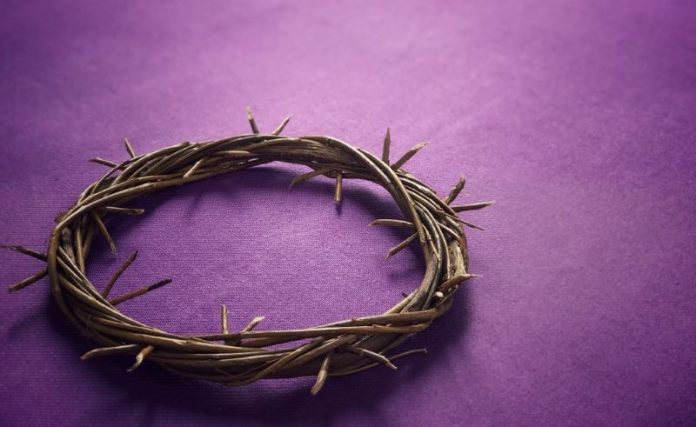
DARIA SOCKEY
The loss of Sunday mass in our parishes has left feeling bereft. We’re scrambling to find live-streamed mass and other ways to keep the Sabbath holy. Now that it’s several weeks into self-isolation, perhaps you’ve settled on a Sunday routine. But we will soon be dealing with a greater loss—that of the Church’s “high holy days” known as the Easter Triduum. Doubtless, all the liturgies will be live-streamed, but that hardly seems enough during these days of anxiety, especially for our children. What can we do to make the holiest of all weeks in the Church calendar memorable—solemn yet joyous, and even—dare I say it—kind of fun? Because doing so will be a distraction from worry and boredom. Who knows? It might even be the start of new annual traditions that will continue long after COVID-19 is just a bad memory.
What follows are the home liturgical customs that our family has observed for years, along with some adaptations for our time of quarantine.
Early Holy Week
Monday, Tuesday, and Wednesday were traditionally days of spring cleaning for European housewives. The idea was to contribute in a very concrete way to our Savior’s work of “making all things new”, or perhaps letting our sparkling clean homes mirror the state of the newly baptized souls. Undoubtedly during these weeks of quarantine, you’ve put some kind of chores in place for your children. But spring-cleaning involves not everyday chores, but rather those things that are only done a few times a year. Make a list of those jobs that don’t get done very often in your house, and from these, choose the ones that your children can easily learn to do. A few ideas: washing windows; removing cobwebs from ceilings with a dust mop or an old t-shirt pulled over a broom; removing items from each kitchen cabinet, cleaning the insides and purging unused items before putting everything else back; cleaning out a closet; raking debris out of garden beds; sweeping out the garage; wiping finger marks off switch plates and door frames; dusting baseboards; getting dead bugs out of ceiling light fixtures. Hopefully, the novelty of these tasks will make them less burdensome.
Continue to do the daily Mass readings, especially the gospel readings which include the dramatic events leading up to Easter. Before doing the reading on Wednesday of Holy Week, tell the kids that this day is sometimes called “Spy Wednesday,” and after listening to the reading, to tell you why this should be so. (Answer: because the reading says that Judas began watching for an opportunity to betray Jesus to the temple authorities. This implies the sly, sneaky behavior we associate with spies.) This might be a good day for an indoor or outdoor game of hide and seek or some other game that involves sneaking and spying. Another game that involves a short kid-friendly lesson on greed for money and the response of Peter vs. Judas upon feeling guilt for sin can be found here at Catholic All Year.
Holy Thursday
Important note: This one involves a special dinner, with recipes that will be new to you, so some advance planning and shopping are required.
The upside is that the recipes are not difficult and that the kids are going to love this. Several of mine tell me that this is their favorite dinner of the year, surpassing that of Thanksgiving, Christmas and Easter Sunday. My married kids still recreate it for their own families, and my single sons do their best to come home for Holy Thursday.
The idea here is to recall elements of the Passover meal Jesus shared with the twelve at the last supper. It is not a lame Christian attempt to hold a seder, a ritualized meal that belongs to the Jewish faith. Here is the menu along with an explanation of each item.
Roast leg of lamb – This recalls the lamb consumed by the Hebrews in Egypt, the blood of which marked their doorposts to save them from the angel of death who “Passed over” their homes during the 10th plague. It recalls the yearly sacrifice of a lamb that Jews offered each year in commemoration of that event, and points to Jesus Christ, the Lamb of God whose death would free us from slavery to sin.
Unleavened bread – (see this recipe) The Hebrews ate unleavened bread before they left Egypt because there was no time to make yeast bread with its long rising times. It also reminds us of the manna in the wilderness that kept the Hebrews nourished while on earth. It was unleavened bread that Jesus took and consecrated at the Last Supper.
Bitter herbs – This is a simple salad made with either romaine or green leaf lettuce, green onion or scallions, and your choice of a few other chopped, fresh herbs, such as cilantro, rosemary, parsley, basil, dill—whatever is available and seems pleasing to you. (At our house we favored parsley and dill for many years, but somewhere along the line switched out dill in favor of cilantro.) The dressing is plain oil and vinegar, going slightly heavy on the vinegar. This is a traditional part of the Passover meal, bringing to mind the “bitterness” of slavery endured by the Hebrews, and for us — the “bitterness” of sin.
Charoset – This is a dish of finely chopped apples and nuts, seasoned with cinnamon, a little honey, and sometimes sweet wine. There are many variations which you can find on an internet search. We add some apricots to our charoset, and the nuts we use are either almonds or walnuts. This dish represents the mortar the Hebrew slaves used to make bricks in Egypt during their years of slavery, but at the same time, the “sweetness” of God’s deliverance.
Wine or grape juice – Our family tradition includes buying Manischewitz kosher wine, which is very sweet. (But feel free to make your own wine or juice selections.) In our home, the kids got a very small glass of Manischewitz (more, depending on their ages) and they loved it. (Refills are grape juice.) The Hebrew letters on the label and statement that it’s “kosher for Passover” are one more little thing to remind us of our spiritual connection to the Jewish people, whom Pope St. John Paul II called “our elder brothers in the faith of Abraham.”
If you think your children are not familiar with the story of the Exodus, then go over it ahead of time, earlier in the week, and/or watch a movie such as The Ten Commandments. As you actually serve this meal, remind them of the story and the significance of each item. You may wish to read aloud Exodus 12:1-14 at the start of the meal before you say grace. In addition, remind them that the Passover meal was what Jesus and His apostles were eating the night before He died. Then ask what new thing Jesus did that night which turned this meal into the very first mass.
Since many people we will not be able to attend Holy Thursday mass this year due to the pandemic, find a live-streamed Mass of the Lord’s Supper. Make a spiritual communion.
At the end of mass, the altar will be stripped, cloths removed. The Blessed Sacrament will be moved from the tabernacle to a side altar. Explain the symbolism: Jesus went forth from the last supper and out to the garden of Gethsemane. Note that the side altar or repository is usually decorated with many flowers to remind us of that garden where Jesus suffered his agony and received strength and courage from His Father through an angel. Reciting the sorrowful mysteries of the Rosary, or at least doing the first decade — the Agony in the Garden — would be appropriate for night prayers.
Sometime in the evening — if she’s not too tired — Mom or one of the family’s kitchen helpers can make the dough for hot cross buns. Here’s a recipe. After step 2 (first rising) 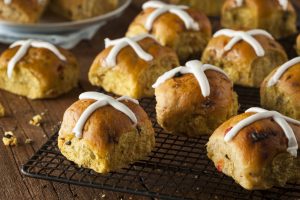 just punch the dough down, put in a covered container, and refrigerate.
just punch the dough down, put in a covered container, and refrigerate.
Good Friday
Mom (or the baker or kitchen helper in your family) gets up early to get the hot cross bun dough out of the fridge, let it rise again, and bake. (If all this sounds like too much trouble, you might be able to find these at your supermarket OR just make your favorite muffin recipe and mark with frosting crosses.) In our family, one hot cross bun plus tea or coffee make each of the “two small meals” of our fasting day on Good Friday.
Today’s activity should be subdued. If you watch any TV at all, let it be a film about the life of Jesus. Encourage quiet play or reading as much as possible.
In a central location in your home, create a Good Friday shrine. On top of a table or bookcase, place a cloth of lace, satin, or other quality fabric. White, purple, or black would be appropriate but use whatever you have that looks appropriate. Lay your largest crucifix on this table, or an icon or other artwork depicting the crucifixion. If you don’t own anything like this, you may be able to find something online and place a tablet or laptop displaying this picture as the focal point of your shrine. Light a candle or two there.
Next, decorate with flowers or plants. If you live in a warm climate in the country or suburbs the children can probably find blooming wildflowers or pick flowers in your garden. If you live in a northern area, purchase cut flowers from the supermarket or bedding plants from a nursery. (If these are not available due to quarantine/ shutdowns, do your best with whatever houseplants or artificial flowers you may already have at home.
This little shrine is meant to recall the altar of repose at your local church. It should be a place where family members might pause as they pass to briefly meditate on the passion of Jesus or to sit nearby to pray or read the bible. (Have one nearby open to one of the Passion narratives in the gospels.)
The Great Silence – Observe this from noon until 3 pm. These are the hours that Jesus 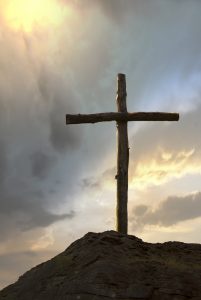 hung upon the cross. In honor of that, we try to maintain silence. This is not easy with anyone under age five, so don’t go crazy trying to enforce it. But older children can enter into the spirit of silence, especially when you make it a challenge.
hung upon the cross. In honor of that, we try to maintain silence. This is not easy with anyone under age five, so don’t go crazy trying to enforce it. But older children can enter into the spirit of silence, especially when you make it a challenge.
Fill in the time with biblical movies, reading, silently doing chores, going for a walk, etc. Silence may be broken for prayer: assuming that live-streamed Good Friday liturgies will be available, any vocalizing done to make the responses is certainly permitted! Make a spiritual communion.
At 3 o’clock, the hour that Jesus died, blow out the candle at your little shrine. Now, or later on Good Friday is a good time to begin the Divine Mercy novena.
Good Friday, of course, is a fast and abstinence day. If your family has been taking it seriously, you’ll be pretty hungry by early evening, so plan for an early dinner. In our family, this was very simple, such as pea or lentil soup and bread, but there was plenty of it. (No dessert.)
The crucifix from our Good Friday shrine is put away, but in the evening, we gather some stones from the garden, looking out for those that are flat on at least one side. Back on our shrine table, we construct what we imagine looks like Jesus’ tomb, with one stone blocking the front opening. We place the flowers behind it, maybe adding some cut branches to resemble trees.
Holy Saturday
Remind the kids what we are thinking about today: Jesus’ body is lying in the holy Sepulcher, but His soul and divinity are active. He “descended into hell” as the apostles’ creed tells us. This means he went to the abode of the dead — where all the people who had died in friendship with God were waiting to be released — waiting for centuries until they could be redeemed by Jesus and enter into heaven. Help your children imagine Adam and Eve, Noah, Moses, Elijah, John the Baptist, St. Joseph, and countless others who welcomed Jesus on this day. (Learn more in the Catechism of the Catholic Church, 631-637.)
Because the work of redemption is now accomplished, the mood of this day is not so sad as it was on Good Friday. Today is the day of last-minute preparations for Easter Sunday.
Although for many, it doesn’t look like we’ll be going to church this Easter, it still might be a good idea to pick out a nice Easter outfit to wear while watching the live-stream Mass. This doesn’t have to be suits and ties and fancy dresses — but consider taking whatever you normally wear at home to the next level: school clothing or business casual rather than sweats and tee shirts.
Do any additional house cleaning — not to make a fetish of having a spotless home, but enough to make the family aware that tomorrow is not just another Sunday.
Go over your Easter menu, whether your custom is a fancy brunch or an Easter dinner in the evening. Do whatever baking or advance meal prep you need to do.
Dye Easter eggs! Let the kids customize eggs with stickers or hand drawn or painted designs. It’s up to you whether to hold Easter egg hunts today or tomorrow (or both). Traditionally in our family, Lenten penances came to an end at noon on Holy Saturday. So, whatever you gave up, get it back!
Our family Easter celebration begins in with Saturday night dinner. After all, it’s Easter Eve, the vigil of the greatest day in the Church year. Starting tonight, and continuing each day for the octave of Easter, we preface grace before meals with this responsory:
Parent: The Lord is risen, Alleluia!
Family: He is truly risen, Alleluia!
Parent: This is the day the Lord has made, Alleluia!
Family: Let us rejoice and be glad, Alleluia!
(Have this responsory printed on individual place cards, or write them on a large poster that everyone can see. After a few meals they will know it by heart.)
Later in the evening, either watch a televised Easter vigil mass, or do the readings from the Mass, or pray the glorious mysteries of the Rosary. Continue with the Divine Mercy novena.
Easter Sunday
If you built the little stone tomb described above, remove the stone that blocks the opening. If you have a small statue of Jesus, place it there. If not, light a small candle, a holy card depicting the Resurrection, or make a small sign at the tomb entrance stating: “He is Risen!”
Most families have traditions involving baskets and bunnies and festive meals, so do 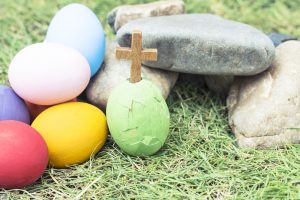 whatever you’ve always done. If you didn’t watch a Vigil mass, watch a live streamed Easter day mass. Spend time calling or Skyping grandparents and other distant relatives. Pray the glorious mysteries of the rosary.
whatever you’ve always done. If you didn’t watch a Vigil mass, watch a live streamed Easter day mass. Spend time calling or Skyping grandparents and other distant relatives. Pray the glorious mysteries of the rosary.
Above all, do whatever you can to make this a day of rejoicing. Yes, this year is strange and different. That does not change the fact that Jesus died for us and conquered sin and death, rising to new life and inviting us to join Him in life unending. That is always a cause for joy.
Daria Sockey has written for Catholic publications for many years. She is author of The Everyday Catholic’s Guide to the Liturgy of the Hours (Franciscan Media) and authored several student texts in the Faith & Life catechetical series (Ignatius Press). She’s a mother of seven, and a grandmother of seven.
Read more articles about catechesis at home during a crisis.
Image credits:
Banner: Coompia77/Shutterstock
Interior: Top: Rick Schroeppel/ Shutterstock 733344616
Middle: Brett Hofacker / Shutterstock 258371120
Bottom: Freedom Studio / Shutterstock 389853250

